Wettability of the Core Rock
Other than poor storage processes causing deterioration of the core, the primary factor that may affect the soundness of special core analysis results is the potential change of the rock’s wettability. Wettability is the tendency of one fluid to adhere to a solid surface in the presence of other immiscible fluids. If there is more than one immiscible fluid within the reservoir, then one of them will be the wetting phase. This wetting phase will completely occupy all the smallest pores and will be in contact with most of the rock surfaces, provided its saturation is sufficiently high. The non-wetting fluid will occupy the centers of the larger pores. That non-wetting fluid occupying the larger pores will tend to have the higher relative permeability.
Reservoir wettability is a critical parameter in many types of oil recovery process. Different reservoirs can have different types of wettability, depending on the adherence of the liquids within the pore surfaces, as follows:
- Fully water-wet, when water occupies the small pores and contacts the majority of the rock surface, with oil occupying the larger pores; perfect wetting state is the extreme wettability state, also known as extremely water-wet rock
- Neutral-wet, when the rock has no strong preference for either oil or water
- Oil-wet, when oil occupies the small pores and contacts the majority of the rock surface, with water occupying the larger pores
- Fractional wettability (also known as heterogeneous, or spotted), when crude oil components are strongly adsorbed in certain areas of the rock, rendering part of the rock oil-wet while the rest is water-wet
The crude oil components, which are adsorbed on the rock surface, are heavy oil components, referred to as surface-active components, like asphaltenes.
The Different Wettability Measures
Wettability measures include contact angle and wettability index.
Contact Angle
Wettability is complex in theory but can be expressed in terms of the contact angle, θ, as shown in Figure 1, with the extreme end point cases of θ = 0° indicating strongly water-wet and θ = 180° indicative of the extremely oil-wet case.
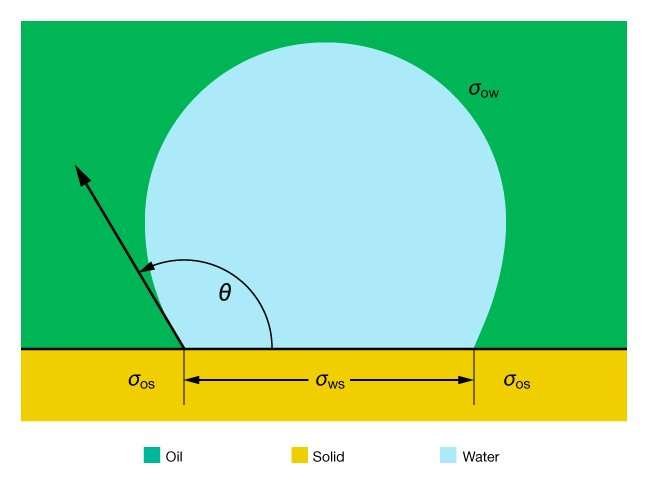
Figure 2 illustrates, with some intermediate stages of water spreading and oil spreading, the contact angles at smooth, solid surfaces.
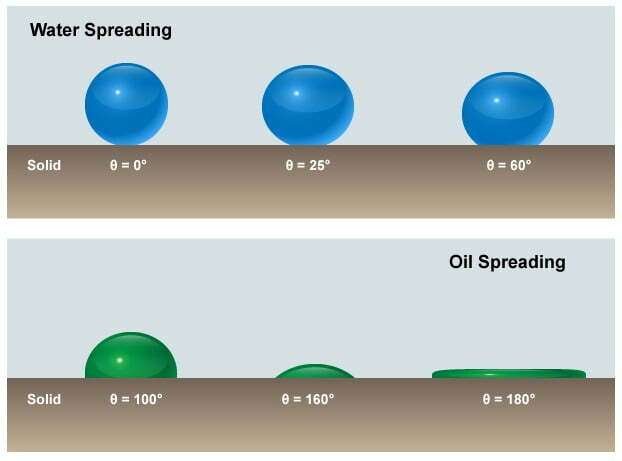
Wettability Index
The wettability index ranges from +1 for the extremely water-wet case to -1 for extremely oil-wet rock. Neutral wettability is designated at 0. The Amott test and the USBM test are the most commonly used methods of characterizing the wettability of oil/brine/rock systems. Both tests depend on capillary pressure and microscopic displacement efficiency. In the application of these tests, the common practice is first to displace water by oil to reach an initial saturation. The sample is then immersed in water, and the oil recovered by spontaneous imbibition is measured. (Imbibition is the process of absorbing a wetting phase into a porous rock.) In the Amott test, the sample is subjected to forced displacement, either by centrifuging or waterflooding. In the USBM test, the sample is subjected to forced displacement of oil by centrifuging while incrementally increasing the speed.
The benefit of measuring the wettability index is that it is the average wettability of the whole core. The contact angle is measured at one specific point.
Table 1 shows the approximate relationship between the wettability, contact angle and the USBM and Amott wettability indexes.
| Water-Wet | Neutrally-Wet | Oil-Wet | |
|---|---|---|---|
| Contact angle (Degree) | |||
| Minimum | 0 | 60-75 | 105-120 |
| Maximum | 60-75 | 105-120 | 180 |
| USBM Wettability Index | W near 1 | W near 0 | W near -1 |
| Amott Wettability Index | |||
| Displacement-by-water ratio | Positive | Zero | Zero |
| Displacement-by-oil-ratio | Zero | Zero | Positive |
| Amott-Harvey wettability index | 0.3 to 1.0 | -0.3 to 0.3 | -1.0 to -0.3 |
Rocks in their initial state are normally water-wet. Many remain in this state permanently, while some become neutral or oil-wet over geological time when contacted by oil that contains surface-active (polar) compounds that are adsorbed on the rock surfaces.
Samples of given original reservoir wettability have been shown to change (Figure 3) because of contact with coring fluids, temperature and pressure effects, core storage and packaging, core exposure and core cleaning activities. In other instances, however, rocks were found to be virtually insensitive to these same factors, indicating that valid results can be obtained in many cases with less than optimum conditions prior to special core analysis.
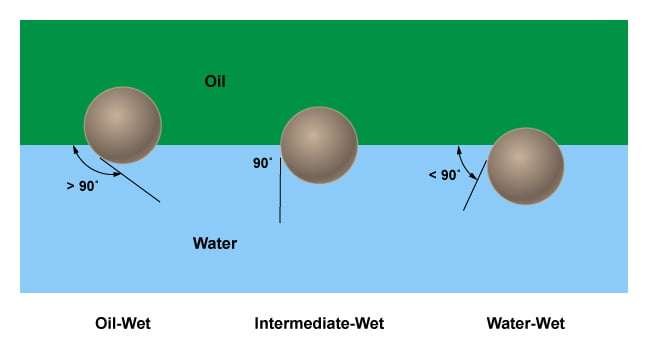
For the determination of a set of representative SCAL data, the wettability state of the core sample in the laboratory should approach as closely as possible the wettability state of the reservoir. Kokkedee et al. (1996) noted that state-of-the-art SCAL measurements at representative wettability conditions, taking account of both relative permeability and capillary pressure artefacts in the interpretation, systematically indicate lower residual oil saturations for a number of reservoirs worldwide. The reduction in residual oil saturation can amount to 10-15 saturation percent compared to the previous estimates.
Much of the usually limited amount of SCAL data in the databases of very mature oilfields is based on experiments conducted in the 1980s, when reservoirs were often assumed to be water-wet (Kokkedee et al., 1996). It is now understood that a significant number of reservoirs tend towards either neutral wettability, or a state of preferential oil wetness (Figure 4).
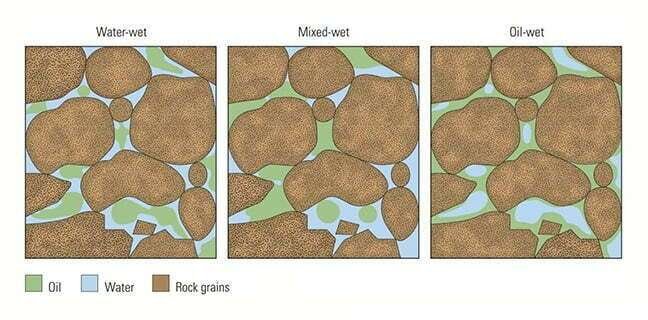
A number of studies have found that significant percentages of both carbonate and sandstone formations appear to be other than strongly water-wet. When the rock is neutral or oil-wet, the laboratory capillary pressure data are likely not to be suitable for the calculation of reservoir water saturations. Masalmeh et al. (2008) demonstrated the importance of SCAL, particularly the drainage and imbibition capillary pressure and relative permeability measurements for the predominant rock types, in modeling the remaining oil saturation in oil-wet carbonate reservoirs under waterflooding.
Water-oil relative permeability (Figure 5) can be measured on extracted cores from water-wet formations. Where the formation is believed to be either intermediate or oil-wet in nature, these tests should be made on samples recovered with oil base coring fluids to which no extraneous water has been added. A native state core is one taken so as to preserve the in-situ water saturation of the rock. Consequently, a native state core is usually drilled with oil base mud, or crude oil from the same reservoir. The assumptions in this case are that the water saturation present in the sample in the laboratory is equal to that in the reservoir, that it is in the proper pore spaces, and that the wettability of the laboratory rock sample mirrors the reservoir wettability. When the formation is oil-wet, the electrical properties may also need to be measured on native state cores.
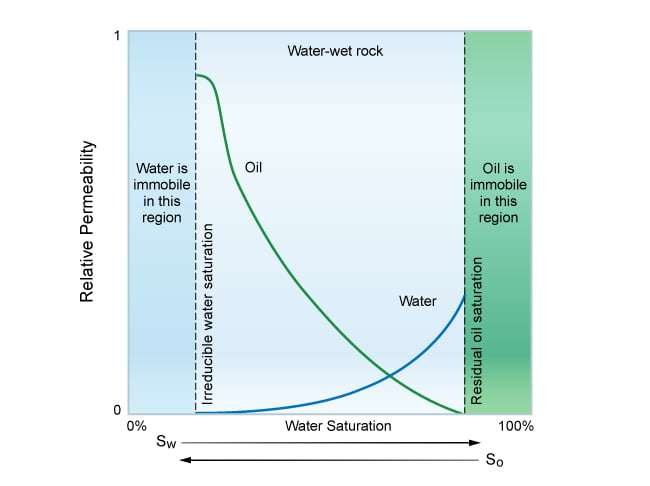
Ma et al. (1999) reviewed methods of interpreting spontaneous imbibition. Imbibition is a key to success in water drive reservoirs, as it can affect the rate of water movement and its areal sweep. These methods can, in certain circumstances such as very strongly water-wet reservoirs and systems that achieve residual oil saturation by spontaneous imbibition, supplement the more commonly used Amott and USBM tests.
 Petro Shine The Place for Oil and Gas Professionals.
Petro Shine The Place for Oil and Gas Professionals.



